The Prominent Fiqures
Aliyev Heydar
 The National Lider of Azerbaijan Heydar Alirza oglu Aliyev was born on 10 May 1923 in the city of Nakhchivan of Azerbaijan Republic. In 1939, after graduating from the Nakhchivan Pedagogical School he studied at the architectural department of the Azerbaijan Industrial Institute (now the Azerbaijan State Oil Academy). The incipient war impeded to complete his education.
The National Lider of Azerbaijan Heydar Alirza oglu Aliyev was born on 10 May 1923 in the city of Nakhchivan of Azerbaijan Republic. In 1939, after graduating from the Nakhchivan Pedagogical School he studied at the architectural department of the Azerbaijan Industrial Institute (now the Azerbaijan State Oil Academy). The incipient war impeded to complete his education.
Since 1941, Heydar Aliyev heads the department at the People Commissariat of Internal Affairs of Nakhchivan ASSR and on 1944 was sent to work at the state security bodies. Heydar Aliyev, working since that time in the security bodies, since 1964 held the post of deputy chairman, and since 1967 – chairman of the Committee of State Security under the Cabinet of Ministers of Azerbaijan Republic, and he was conferred the rank of lieutenant general. In these years, he received special higher education in Leningrad (now St Petersburg), and in 1957, he graduated from the history department of Azerbaijan State University.
Being elected at the Plenum of the Central Committee of the Communist Party of Azerbaijan in July 1969 as the First Secretary of the Central Committee of the Communist Party of Azerbaijan, Heydar Aliyev heads the Republic. In December 1982, Heydar Aliyev has been elected as Alternate member of Politburo of the Central Committee of the Communist Party of Soviet Union, and appointed at the post of the First Deputy Chairman of the Cabinet of Ministers of the USSR and became one of the leaders of the USSR. During twenty years, Heydar Aliyev was the Deputy of the Supreme Soviet of the USSR and for five years was Deputy Chairman of the Supreme Soviet of the USSR.
In October 1987, Heydar Aliyev, as a sign of protest against the policy pursued by Politburo of the Central Committee of the Communist Party of the Soviet Union and personally the Secretary General Michael Gorbachev, resigned from his post.
In bound with the tragedy, committed on 20 January 1990 in Baku by the soviet troops, appearing on the next day at the Azerbaijan Representation in Moscow with a statement, demanded to punish the organizers and executors of the crime, committed against the people of Azerbaijan. As a sign of protest against the hypocritical policy of leadership of the USSR, in connection with the critical conflict accrued in Nagorno Karabakh, in July 1991, he left the Communist Party of the Soviet Union.
By return in July 1990 to Azerbaijan, Heydar Aliyev has lived at first in Baku, then in Nakhchivan, and on the same year he was elected as the Deputy to the Supreme Soviet of Azerbaijan. In 1991-1993s, he held the post of Chairman of the Supreme Mejlis of the Nakhchivan Autonomous Republic, Deputy Chairman of the Supreme Soviet of the Republic of Azerbaijan. In 1992, at the constituent congress of the "Yeni Azerbaijan" Party in Nakhchivan, Heydar Aliyev, was elected as the Chairman of the Party.
In May-June 1993, when, as the result of extreme tension of the governmental crisis, the country was at the verge of civil war and loss of independence, the people of Azerbaijan demanded to bring to power Heydar Aliyev. The then leaders of Azerbaijan were obliged to officially invite Heydar Aliyev to Baku. On 15 June 1993, Heydar Aliyev was elected as the Chairman of the Supreme Soviet of Azerbaijan, and on 24 July - on resolution of the Milli Mejlis, he managed to fulfill powers of the President of Azerbaijan Republic.
On October 3, 1993, as the result of nationwide voting, Heydar Aliyev was elected as the President of Azerbaijan Republic. On October 11, 1998, having garnered at the elections, passed in high activeness of the population, 76,1 percent of the votes, he was re-elected as the President of Azerbaijan Republic. Heydar Aliyev, giving his consent to be nominated as a candidate at the 15 October 2003 presidential elections, Heydar Aliyev relinquished to run at the elections in connection with health problems.
On December 12 national leader of Azerbaijan, President Heydar Aliyev passed away in Cleveland hospital in the United States of America.
Azerbaijani national leader Heydar Aliyev passed away on December 12, 2003 in Cleveland hospital in the United States.
Heydar Aliyev was awarded the Lenin’s Order four times, Order of the Red Star and many other medals, was named the Hero of Socialist Labour twice and awarded with orders and medals of many foreign countries. He has also received orders and medals of many international awards, was elected as an honorary doctor of universities in different countries.
Heydar Alirza oglu Aliyev's spouse - Aliyeva Zarifa Aziz gyzy (1923-1985) was an ophthalmologist, doctor of medical sciences, professor, and academician of the Academy of Sciences of Azerbaijan. His son, Ilham Heydar oglu Aliyev, was elected the President of the Republic of Azerbaijan in 2003, 2008 and 2013.
Aliyeva Zarifa
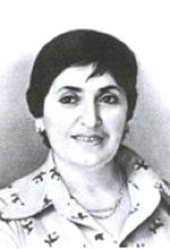 The honored scientist of the Republic of Azerbaijan, doctor of medical sciences and academician of Azerbaijani Scientific Academy Zarifa Aliyeva Aziz was born on the 28th of April in 1923 in Shahtakhti village of Sharur region. She was Aziz Aliyev’s daughter and Haydar Aliyev’s wife. She graduated from Azerbaijan State Medical Institute (present Medical University) (1947). She worked as a scientific worker at Azerbaijani Scientific-Research Institute of Ophthalmology, senior lecturer, and professor of the Eyes diseases chair, head of the laboratory of vacation pathology of eye organs and head of the chair of Ophthalmology at Azerbaijani Doctors Improvement Institute named after (1982-1985). Z. Aliyeva did exceptional things in the development of the science of ophthalmology. She is the author of a lot of capacious researches on the analyze of trachoma widespread in Azerbaijan, the top vocational diseases in the world, especially eye diseases connected with the vocational activities in chemical an electron industries, of its prevention and treatment and the modern problems of ophthalmology, as well as one of the authors of the unique scientific works “Therapeutic ophthalmology” and “The principals of iridodiagnosis”.
She wrote 12 monographs, manuals, about 150 scientific works, one invention and 12 rationalization proposals. Zarifa Aliyeva did many things in the training high-qualified medical staff. She was a member of the Presidium of the All-Union Ophthalmologists society, Soviet Peace Defense Committee, the Executive Board of the Azerbaijani Ophthalmologic Society and the editorial staff of “The Vestnik ophthalmologu” magazine (Moscow). She was awarded with the price of M.I. Averbach of the Medical Scientific Academy of the USSR (1981). Z.Aliyeva died on the 15th of April in 1985 in Moscow. Her corpse was brought from Novo-Devichya cemetery in Moscow to Baku and was buried in Fakhri Khiyaban (Honored Avenue) near her father’s grave. A bronze monument was erected on her grave. Z.Aliyeva’s name has been given to the Eye Diseases Institute in Baku, Nakhchivan city policlinic and a street in Nakhchivan. A recreation park named Z.Aliyeva has been laid out in Binagadi district of Baku.
The honored scientist of the Republic of Azerbaijan, doctor of medical sciences and academician of Azerbaijani Scientific Academy Zarifa Aliyeva Aziz was born on the 28th of April in 1923 in Shahtakhti village of Sharur region. She was Aziz Aliyev’s daughter and Haydar Aliyev’s wife. She graduated from Azerbaijan State Medical Institute (present Medical University) (1947). She worked as a scientific worker at Azerbaijani Scientific-Research Institute of Ophthalmology, senior lecturer, and professor of the Eyes diseases chair, head of the laboratory of vacation pathology of eye organs and head of the chair of Ophthalmology at Azerbaijani Doctors Improvement Institute named after (1982-1985). Z. Aliyeva did exceptional things in the development of the science of ophthalmology. She is the author of a lot of capacious researches on the analyze of trachoma widespread in Azerbaijan, the top vocational diseases in the world, especially eye diseases connected with the vocational activities in chemical an electron industries, of its prevention and treatment and the modern problems of ophthalmology, as well as one of the authors of the unique scientific works “Therapeutic ophthalmology” and “The principals of iridodiagnosis”.
She wrote 12 monographs, manuals, about 150 scientific works, one invention and 12 rationalization proposals. Zarifa Aliyeva did many things in the training high-qualified medical staff. She was a member of the Presidium of the All-Union Ophthalmologists society, Soviet Peace Defense Committee, the Executive Board of the Azerbaijani Ophthalmologic Society and the editorial staff of “The Vestnik ophthalmologu” magazine (Moscow). She was awarded with the price of M.I. Averbach of the Medical Scientific Academy of the USSR (1981). Z.Aliyeva died on the 15th of April in 1985 in Moscow. Her corpse was brought from Novo-Devichya cemetery in Moscow to Baku and was buried in Fakhri Khiyaban (Honored Avenue) near her father’s grave. A bronze monument was erected on her grave. Z.Aliyeva’s name has been given to the Eye Diseases Institute in Baku, Nakhchivan city policlinic and a street in Nakhchivan. A recreation park named Z.Aliyeva has been laid out in Binagadi district of Baku.
Ajami’s creative activity strongly affected the architecture of Azerbaijan and the Middle East countries – Ajami’s traditions live in Blue dome in Maragha (1196), Gulustan dome near Nakhchivan (XIII), Garabaglar dome (XII-XIV), Barda and Salma domes (XIV) and in the tombs built by Turkish architect Sinan in Istanbul. During the construction of the monument on Nizami’s grave in Ganja the style of Ajami was used and the monument was built with the spirit of Ajami genius.
“One-tenth of the century” novel by H.Ibrahimov and “He was the son of our mountains” play by Kemale was devoted to Ajami. His 850 years anniversary was celebrated on a large scale in 1976. Ajami Nakhchivanski’s bust was opened in Nakhchivan.
Aziz Sharif
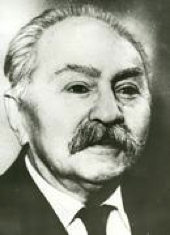 Abdulaziz Meshedi Gurbanali ogly Sharifzadeh (Aziz Sharif) was born on March 28, 1895 in Nakhchivan city. He had completed his secondary education in Tiflis.
His literary activity has started with “Letters form Nakhchivan” published in “Molla Nasreddin” magazine. During first years of the work in editorial of “Molla Nasreddin” magazine his close relations with Mirza Alakbar Sabir, Abdurrahim beyHaqverdiyev, Huseyn Javid and Aligulu Gemkusar associated his life to literary activity. He continued his education at the Moscow Institute of Commerce (1915-1917) and got familiar with the Russian literary environment. He worked in the field of media and publishing in Tiflis (1920-1930). He has been a consultant to the Caucasus Central Executive Committee (1925-1935). He graduated from the department of criticism at the Institute of Literature named after M. Gorky in Moscow (1943). Later he worked as a senior researcher at the Institute of Oriental Studies of the USSR Academy of Sciences and the Institute of World Literature (1950-1961). He held the position of a professor at the department of the USSR people’s literature at the Philological faculty of Moscow State University (1961-1988).
Abdulaziz Meshedi Gurbanali ogly Sharifzadeh (Aziz Sharif) was born on March 28, 1895 in Nakhchivan city. He had completed his secondary education in Tiflis.
His literary activity has started with “Letters form Nakhchivan” published in “Molla Nasreddin” magazine. During first years of the work in editorial of “Molla Nasreddin” magazine his close relations with Mirza Alakbar Sabir, Abdurrahim beyHaqverdiyev, Huseyn Javid and Aligulu Gemkusar associated his life to literary activity. He continued his education at the Moscow Institute of Commerce (1915-1917) and got familiar with the Russian literary environment. He worked in the field of media and publishing in Tiflis (1920-1930). He has been a consultant to the Caucasus Central Executive Committee (1925-1935). He graduated from the department of criticism at the Institute of Literature named after M. Gorky in Moscow (1943). Later he worked as a senior researcher at the Institute of Oriental Studies of the USSR Academy of Sciences and the Institute of World Literature (1950-1961). He held the position of a professor at the department of the USSR people’s literature at the Philological faculty of Moscow State University (1961-1988).
He was actively involved in criticism and literature, as well as literary translations. He translated a lot of Azerbaijan literature into Russian, wrote forewords, prefaces to them and made written comments.
Aziz Sharif has died in 1989 at the age of 94 in Moscow and was buried in Nakhchivan.
Elchibey Abulfaz
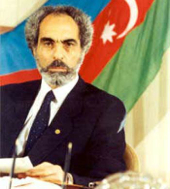 Abulfaz Qadirqulu oglu Aliyev (Elchibey) was born on June 24, 1938, in the town of Keleki of Ordubad district. He was a scientist-orientalist, political figure, statesman, Candidate of Historical Sciences. He graduated from the oriental studies faculty of the Azerbaijan State University, in 1962.
In 1962-1963 Elchibey worked as a translator at the Baku branch of the Russian State Hydrological Institute. During the construction of the Aswan dam, in Egypt, in 1963-1964 he worked as a translator. In 1965-1968 he was taking a post-graduate course at the ASU, in 168-1975 he was a lecturer there. After protesting Soviet policies in the region, in 1975 he was jailed by the Committee for State Security. After discharge from prison, in 1976 he was unemployed for some period of time. During the period of 1977-1992 he worked first as a research assistant and then a senior staff scientist at the Institute of Manuscripts under the Azerbaijan National Academy of Sciences. Being a student Abulfaz Aliyev struggled actively against the Soviet empire for independence of Azerbaijan. Due to this he was popular with young people of Azerbaijan. In 1989 the political organization named the Azerbaijani Popular Front was founded and Elchibey became its chairman. In June, 1992 he was elected the president of the Azerbaijan Republic. After a year, when the revolt in Ganja happened, he left politics and returned to his native village Keleki. In 1997 he returned to Baku where during his last years he headed the opposition party of the Popular Front.
Abulfaz Qadirqulu oglu Aliyev (Elchibey) was born on June 24, 1938, in the town of Keleki of Ordubad district. He was a scientist-orientalist, political figure, statesman, Candidate of Historical Sciences. He graduated from the oriental studies faculty of the Azerbaijan State University, in 1962.
In 1962-1963 Elchibey worked as a translator at the Baku branch of the Russian State Hydrological Institute. During the construction of the Aswan dam, in Egypt, in 1963-1964 he worked as a translator. In 1965-1968 he was taking a post-graduate course at the ASU, in 168-1975 he was a lecturer there. After protesting Soviet policies in the region, in 1975 he was jailed by the Committee for State Security. After discharge from prison, in 1976 he was unemployed for some period of time. During the period of 1977-1992 he worked first as a research assistant and then a senior staff scientist at the Institute of Manuscripts under the Azerbaijan National Academy of Sciences. Being a student Abulfaz Aliyev struggled actively against the Soviet empire for independence of Azerbaijan. Due to this he was popular with young people of Azerbaijan. In 1989 the political organization named the Azerbaijani Popular Front was founded and Elchibey became its chairman. In June, 1992 he was elected the president of the Azerbaijan Republic. After a year, when the revolt in Ganja happened, he left politics and returned to his native village Keleki. In 1997 he returned to Baku where during his last years he headed the opposition party of the Popular Front.
Abulfaz Elchibey died on 22 August 2000 in Ankara, Turkey. He was buried at the Fakhri Khiyaban (The Alley of Honor) cemetery in Baku.
Fazlullah Naimi
Naimi Shahabaddin Fazlullah Tabrizi Astabadi (about 1339-40-1402 years)-a poet, thinker. He founded the hurifism trend (religion sector) widely spread in Middle ages in Near and Middle East. Naimi gave an explanation to the main principals of systematic pantheism which is the philosophical basis of hurifism in his treaties of “Javidani-Saghir”, “Mahabbatname”, ”Arshiname” and partially in his works “Novmname”(“About the dreams”) and “Divan”. His main work is “Javidani-Kabir”(“Javidanname”)- the followers of hurifism believed that the God personified in Fazlullah and as an example of the God in the earth he would remove the injustice. According to the sources Teymuries persecuted Naimi to the fortress of Alinja, with the order of Teymur he was caught by Teymur’s son Miranshah and was executed there, because of his propagation of hurifism and his firm political struggle against authorities
Huseyn Javid
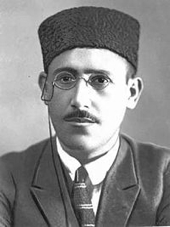 Huseyn Abdulla oglu Rasizadeh was born in 1880 to a family of a theologian in Nakhchivan in the Erivan Governorate. After completing his elementary education at a religious school in 1898, Javid pursued his mid-school education in the Maktab-i Tarbiya of Mashadi Taghi Sidgi. In 1899–1903, Huseyn Javid studied in the Talibiyya Madrasah in Tabriz. After obtaining a degree in literature at the Istanbul University in 1909, Javid worked as a teacher in Nakhchivan, Ganja and Tiflis, and starting from 1915 in Baku.
Huseyn Abdulla oglu Rasizadeh was born in 1880 to a family of a theologian in Nakhchivan in the Erivan Governorate. After completing his elementary education at a religious school in 1898, Javid pursued his mid-school education in the Maktab-i Tarbiya of Mashadi Taghi Sidgi. In 1899–1903, Huseyn Javid studied in the Talibiyya Madrasah in Tabriz. After obtaining a degree in literature at the Istanbul University in 1909, Javid worked as a teacher in Nakhchivan, Ganja and Tiflis, and starting from 1915 in Baku.
Huseyn Javid's first book of lyrical poems titled Kechmish gunlar ("The Past Days") was published in 1913. However Javid was known more as a playwright. His philosophical and epic tragedies, and family dramas introduce a new line of development in Azerbaijani literature. In his literary tragedy Sheikh Sanan (1914), Huseyn Javid philosophized about the idea of a universal religion to lift inter-religious barrier between humans. His most famous creation, Iblis ("The Satan") published in 1918, exposed all oppressive forces as the supporters of "humans are wolves to each other" philosophy and "the 20th century cultural savages", and summarized them in the character of Satan. In his works, Javid criticized any form of colonialism and oppression.
During the 1920s and 1930s, Huseyn Javid authored a number of historical epics, such as “Peyghambar” ("The Prophet") in 1922, “Topal Teymur” ("Timur") in 1925, “Sayavush” ("Siyâvash") in 1933 and “Khayyam” ("Khayyám") in 1935.
Huseyn Javid wrote during the difficult time of Collectivization and Stalin purges in the Soviet Azerbaijan. In the worst times of totalitarianism, he refused to serve as propagandist of "revolutionary socialist achievements". Javid was arrested in 1937 on trumped up charges of being a "founding member of a counter-revolutionary group that was plotting an overthrow of the Soviet power". His arrest was a part of the nation-wide campaign of purge against intelligentsia. The Soviet government exiled Huseyn Javid to the Far East, where he died on 5 December 1941 in the city of Magadan. Huseyn Javid was officially exonerated in 1956. His repatriation came only on Javid's 100th birthday in 1982, when his remains were moved from Magadan back to his homeland of Nakhchivan and reburied in a mausoleum built in Javid's honor.
Huseyn Javid’s 100 and 110 years anniversary ceremonies were tremendously celebrated. His memorial houses were created in Nakhchivan and Baku and a bas-relief memorial board was set up on the building he lived in Baku. With Heydar Aliyev’s initiative his corpse was brought from Irkutsk province to Nakhchivan and was buried there near his memorial house. And again with Haydar Aliyev’s initiative a grandiose tomb was constructed on his grave (1996). In 1982 “Huseyn Javid poetry theatre” was opened in Nakhchivan. There are a lot of streets; gardens, schools, libraries, cinemas and other academic institutions in Baku, Nakhchivan and other regions of Azerbaijan were named after him. His majestic monument has been erected in Baku
Kangarli Behruz
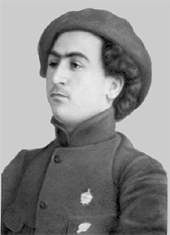 Kangarli Behruz (Shamil) Shiralibey (22.1.1892, Nakhchivan – 7.2.1922, Nakhchivan) – an artist, painter and graphic. The formation of realist worktable painting and the formation of portrait and landscape as an independent genre in Azerbaijan painting is directly related with Kangarli’s name. When he was a child he survived from the serious disease and he could hardly hear, therefore he could not go to school and displays his interest to drawing and drew the things that he saw on the paper with his child fantasy.He studied at the School of Painting and Sculpture attached to the Caucasus Art Tashviq Society in Tbilisi (1910-1915).
A rich literary heritage of Kangarli remains. He drew a lot of portraits, landscapes, still live works etc. that became attracted with its realist expressions and high literary-esthetic value. His portraits of the present popular educated figures and simple people’s (“Old man”, “Georgian” etc.) differs with subject topicality and the aliveness and reality of the portraits of a man, woman, boy and a girl who belong to the group of “Refugees” and its psychological expression, which is one of the important issues of present social-political issues. The landscapes contain great part in his creative activity. The natural beauties (“Shalab”, “Mountainous View”, Ilanlidag in the moonlight”, “Sunset”, “Agridag”, “Old fortress”, “Gate in Aliabad village”, “Way to Yamkhana village”, “Ashabi-kahf mountain” etc.), the cultural monuments (“Momuna Khatun Tomb”), the seasons (“Autumn”, “Spring”) are reflected in his landscapes. In 1921, at the first great exhibition in Azerbaijan, Kangarli’s more than 500 works were exhibited. His works are kept at the State Art Museum of Azerbaijan, Nakhchivan State Museum of History, Moscow State Museum of History and private collections.
Kangarli Behruz (Shamil) Shiralibey (22.1.1892, Nakhchivan – 7.2.1922, Nakhchivan) – an artist, painter and graphic. The formation of realist worktable painting and the formation of portrait and landscape as an independent genre in Azerbaijan painting is directly related with Kangarli’s name. When he was a child he survived from the serious disease and he could hardly hear, therefore he could not go to school and displays his interest to drawing and drew the things that he saw on the paper with his child fantasy.He studied at the School of Painting and Sculpture attached to the Caucasus Art Tashviq Society in Tbilisi (1910-1915).
A rich literary heritage of Kangarli remains. He drew a lot of portraits, landscapes, still live works etc. that became attracted with its realist expressions and high literary-esthetic value. His portraits of the present popular educated figures and simple people’s (“Old man”, “Georgian” etc.) differs with subject topicality and the aliveness and reality of the portraits of a man, woman, boy and a girl who belong to the group of “Refugees” and its psychological expression, which is one of the important issues of present social-political issues. The landscapes contain great part in his creative activity. The natural beauties (“Shalab”, “Mountainous View”, Ilanlidag in the moonlight”, “Sunset”, “Agridag”, “Old fortress”, “Gate in Aliabad village”, “Way to Yamkhana village”, “Ashabi-kahf mountain” etc.), the cultural monuments (“Momuna Khatun Tomb”), the seasons (“Autumn”, “Spring”) are reflected in his landscapes. In 1921, at the first great exhibition in Azerbaijan, Kangarli’s more than 500 works were exhibited. His works are kept at the State Art Museum of Azerbaijan, Nakhchivan State Museum of History, Moscow State Museum of History and private collections.
His museum was created in Nakhchivan on the basis of the decision of the Supreme Assembly of Nakhchivan Autonomous Republic about “The memorization of Behruz Kangarli’s name” (May 22, 2001).
Kangarli Ehsan Khan
Kangarli Ehsan Khan Kalbali Khan oglu (?, Nakhchivan -?, there) –The last Khan of Nakhchivan. He is the son of Kalbali Khan Kangarli, the father of Ismail Khan Nakhchivanski, Kalbali Khan Nakhchivanski and Goncha bayim. He was one of the army chiefs of the Abbasabad garrison duting the Russia –Iran war in 1826-28 but the colonel of the Iran army Ehsan Khan Kangarli took the side of the Russians and helped them in taking the fortress. According to the historical sources Ehsan Khan Kangarli headed the troop of ten thousand considering of Nakhchivanis and Russians. Ehsan Khan Kangarli who was awarded with the highest military rank major-general thereafter joining Azerbaijan to Russia signed the Turkmenchay treaty (1828) as an authorized member the Iravan and Nakhchivan Khanate and Ordubad province and as soon as was abolished he became the first ruler of the Nakhchivan province. Ehsan Khan paid great attention to the construction works and world-wide education. He made dig springs in Cheshmabasar village, delivered water to Nehram from under the tunnel of the hill and opened the first Rus-Tatar (Azerbaijan) uyezd school in Nakhchivan. In 1840 he refused from ruling under the condition of heading a cavalry. Later he also bravely fought in the Crimea war (1853-56). He was awarded with the “Saint George” order. When A.Bakikhanov and A.S.Griboyedov visited Iran they were guested in the palace of Ehsan Khan Kangarli which is stated in the “Iravan marching” road notes. The name of Ehsan Khan Kangarli was written in golden letter in the George salon of the Kremlin.
Haydar Quli Khan Kangarli
Haydar Quli Khan Kangarli (?-1763/64) – the Khan of Nakhchivan [1763/64]. The khanate was ruled by local Azeri-Turkic Kangarli dynasty and the population of the khanate was mostly Muslim (Azeri-Turkic and Kurdish). The khanate was founded in 1747 by the head of a dynasty Kengerli - Haydar Quli Khan, who stripped the regent Aghakhasani of power after the murder of Nadir Shah Afshar, organized by his courtiers and declared himself the independent Khan (ruler) of Nakhchivan. For strengthening the khanate, increasing the income of treasury and also for art developing he took such measures as: establishment of good relations with other khanates and also gives the order for old bridges’ repair and construction of the new ones.
The Nakhchivan Khanate hadn’t adequate military force for that period, so Haydar Quli Khan tried to derive encouragement from more powerful khanates. For this purpose he became an ally of the Karabakh khan – Panakhali Khan, and they both together with the Georgian tsar Irakli II participated in a campaign against the khan of Shaki - Haji Chalabi Khan, in 1752. After an unsuccessful campaign Haydar Quli Khan was engaged in settlement of an economic condition of the khanate. Haji Khan Kangarli came to power after his death.
Mahmudbayov Shamil
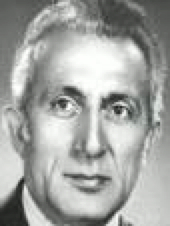 Mahmudbayov Shamil Faramaz oglu was born on December 5, 1924, in the city of Nakhchivan.
Mahmudbayov Shamil Faramaz oglu was born on December 5, 1924, in the city of Nakhchivan.
At first he graduated from the railway college in Baku, then during the World War 2 the Grozny military-technical school.
Since 1948 until the end of his life he had worked at the film studio “Azerbaijanfilm”.
In 1954he graduated from the All-Union State Institute of Cinematography in Moscow. First he produced the documentaries and short films, later on he shot full-length feature films. “Romeo is my neighbour” (1963), “Gypsy girl” (1965), “Land. Sea. Fire. Sky” (1967), “Shared bread” (1969), “Life tests us” (1971), “Violin adventure” (1972), “Dervish blows up Paris” (1976, together with K. Rustambeyov), “When owl comes” (1978), “Inside the fire” (1978) are the best feature films of Shamil Mahmudbayov. Sh. Mahmudbayov was the director of 37 feature and documentary films over the years of creative work.
In 1976, Sh. Mahmudbayov was awarded an honorary title of Honoured Art Worker of the Azerbaijan SSR, and in 1969, the State Prize Laureate of the Azerbaijan SSR.
He died on June 18, 1997 in Baku.
Mammad Araz
 Ibrahimov Mammad Infil oglu was born on October 14, 1933, in Nurs village of Shahbuz district of Nakhchivan Autonomous Republic. In 1940 he went to school in Nurs village of Shahbuz district. In 1945, his father was attached a stigma of “nation’s enemy” and sent into exile to Siberia.
Ibrahimov Mammad Infil oglu was born on October 14, 1933, in Nurs village of Shahbuz district of Nakhchivan Autonomous Republic. In 1940 he went to school in Nurs village of Shahbuz district. In 1945, his father was attached a stigma of “nation’s enemy” and sent into exile to Siberia.
In 1950, he entered the geography department of Azerbaijan Pedagogical Institute, at the same time he went on with his literary activity. He participated in the activities of the literary association established by the prominent Azerbaijani writer Ismayil Shikhli in 1951. In 1954, he graduated from Azerbaijan Pedagogical Institute. He read the poem “Parting” dedicated to the graduates at the graduation ceremony.
In the years 1955-1956 he worked as a teacher in Nurs village of Shahbuz district. In 1957, he was appointed attorney at the Head Press Office under the Azerbaijan Council of Ministers. He became a member of the Azerbaijan Writers’ Union in 1957. On November 8, 1958, he got married. The first book of poems titled “Sevgi naghmasi” (Love song) was published in 1959, in “Azerneshr” publishing house.
In 1959, he entered the two-year higher course of literature under the USSR Union of Soviet Writers in Moscow. He was promoted fiction editorial director in Azerbaijan State Publishing House in 1963.
Mammad Araz headed the poetry department of Azerbaijan Writers’ Union in the years 1971-1980. In 1974, he was appointed editor-in-chief of the newly published “Nature of Azerbaijan” magazine and he worked there until the end of his life. His publicist book titled “Colours of life and word” was published in 1974.
On December 7, 1991 Mammad Araz was awarded an honorary title of People’s Poet of the Republic of Azerbaijan. In 1995 he was awarded the order of “Istiglal”, the highest prize of Azerbaijan.
In 1997, the book “Talk at the crossroads”, in 2001, the publicist book “There is no end in literary activity” was published. In 2002, the book titled “Rock-recorded voice” was published in Arabic alphabet in Tabriz. By the resolution of the government the two-volume edition was published in 2004.
Mammad Araz died on December 1, 2004. He was buried in the Alley of Honour.
Mammedaliyev Yusif
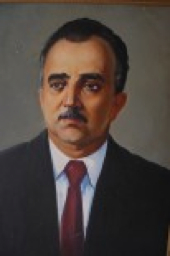 Yusif Heydar oglu Mamedaliyev was born in town of Ordubad of the Nakhchivan Autonomous Republic of Azerbaijan in 1905.
Yusif Heydar oglu Mamedaliyev was born in town of Ordubad of the Nakhchivan Autonomous Republic of Azerbaijan in 1905.
Y. Mamedaliyev was elected as a President of the Academy of Sciences in 1947-1951 and 1958- 1961.
He graduated from the Azerbaijan Higher Pedagogical Institute in 1926.
He received his Doctor of Chemical Sciences degree and was awarded professorship in 1942. In 1945 he was elected as Academician of the Academy of Sciences. After foundation of the Academy of Sciences of the Azerbaijan Soviet Socialist Republic of the USSR he was a Head of Petroleum Institute. In 1951-1954 he was an Academician Secretary of the Section of Physics, Chemistry and Oil of the Academy of Sciences and in 1954-1958 he was a Rector of the Azerbaijan State University.
The catalytic processing of oil and oil gases was the main area of his research. He was a founder of petroleum chemistry in Azerbaijan. He proposed new methods of chlorination and brominating of various hydrocarbons with the use catalysts and showed the ways of obtaining coal-tetra-chloride, methyl chloride, methylene chloride and other valuable products with aid of chlorination of methane, first, with stationery catalyst and, then, on the hot layer. His research in the field of catalytic algidation of aromatic, paraffin, cyclic paraffin hydrocarbons with aid of unsaturated hydrocarbons created an opportunity for synthesis on industrial scale of components of aviation fuel.
He obtained important results in the fields of catalytic aromatisation of benzene fraction of Baku oil, synthesis of detergents, silicon organic compounds, mass production of plastics from pyrolized products, studies of mechanisms of effect of Naftalan oil.
Yusif Mamedaliyev had great merit in preparation of highly qualified scientific cadre in Azerbaijan. He numerously represented Azerbaijan at scientific symposiums, congresses and forums hosted in USSR, USA, Italy, France, England, Poland, Mongolia and other countries.
The creation of Azerbaijan Astrophysical Observatory, Repository of Manuscripts, and Scientific Chemical Centre in Sumgayit are connected with his name.
The Azerbaijan Scientific Petrochemical School created by him is well known beyond the country.
He was awarded with Orders of Lenin, Labour Red Banner and Glory and a number of supreme medals of the Former Soviet Union. He was an author to more than 200 scientific publications, including 6 monographs.
Yusif Mamedaliyev died in 1961 in Baku.
Mammedguluzadeh Jalil
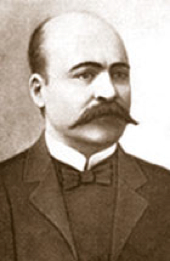 Jalil Huseyngulu oglu Mammadguluzadeh was an Azerbaijani satirist and writer, he was born on 22 February 1866 in Nakhchivan. In 1887, he graduated from the Gori Pedagogical Seminary and for the next 10 years was involved in teaching at rural schools in Bash-Norashen, Ulukhanli, Nehram and other towns and villages of the Erivan Governorate. Mammadguluzadeh was a strong activistof the language unification movement. He condemned many of his contemporaries for corrupting the Azeri language replacing its genuine vocabulary with the newly-introduced Russian, Persian and Ottoman Turkish loanwords, often alien and confusing to many readers. Later he became deeply involved in the process of romanization of the Azeri alphabet. In 1898, he moved to Erivan and in 1903, – to Tiflis where he became a columnist for the local Sharqi-Rus newspaper published in the Azeri language. In 1906, he founded the Molla Nasraddin satirical magazine. Frequent military conflicts and overall political instability in the Caucasus forced him to move to Tabriz, Iran, where he continued his career as a chief-editor and columnist for Molla Nasraddin. He eventually settled in Baku in 1921.
Jalil Huseyngulu oglu Mammadguluzadeh was an Azerbaijani satirist and writer, he was born on 22 February 1866 in Nakhchivan. In 1887, he graduated from the Gori Pedagogical Seminary and for the next 10 years was involved in teaching at rural schools in Bash-Norashen, Ulukhanli, Nehram and other towns and villages of the Erivan Governorate. Mammadguluzadeh was a strong activistof the language unification movement. He condemned many of his contemporaries for corrupting the Azeri language replacing its genuine vocabulary with the newly-introduced Russian, Persian and Ottoman Turkish loanwords, often alien and confusing to many readers. Later he became deeply involved in the process of romanization of the Azeri alphabet. In 1898, he moved to Erivan and in 1903, – to Tiflis where he became a columnist for the local Sharqi-Rus newspaper published in the Azeri language. In 1906, he founded the Molla Nasraddin satirical magazine. Frequent military conflicts and overall political instability in the Caucasus forced him to move to Tabriz, Iran, where he continued his career as a chief-editor and columnist for Molla Nasraddin. He eventually settled in Baku in 1921.
In 1907, the twice-widowed Jalil Mammadguluzadeh married Azerbaijani philantropist and activist Hamida Javanshir. He died in Baku, in 1932. A drama theatre in Nakhchivan, a street in Baku, the city of Jalilabad (former Astrakhan-Bazaar) and the town of Jalilkand (former Bash-Norashen) were named after him.
Nakhchivani Ajami
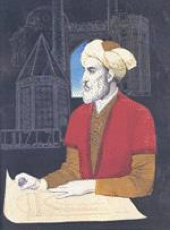 Ajami Nakhchivani Abubakr (20th years of XII century – the end of XII) – an architect. A famous representative of the architecture of Azerbaijan, the founder of Nakhchivan architecture school. Ajami granted the architecture of Azerbaijan with a new direction and brought a tenderness, dynamic to the rude and firm style of the architecture during Saljugs regime with his genius and strongly influenced the architecture of Middle East. Ajami has an honourable place among the names of famous faces in the XII century, when the reform and humanism ideas became spread in the public opinion of Azerbaijan. At the same time, Ajami is distinguished from other present architects with that the things, he created, possessed knowledge of science. He calls himself “Ajami son of Abubakr, architect from Nakhchivan” and his synthetic combination of engineering and architecture is obviously seen in the inscriptions on the monuments he made. The great geniuses of the east called him “sheykhul-muhandis’ (head of the engineers).
Ajami’s creative activity is closely related with Nakhchivan, the capital of strong Atabeys state in XII century. Ajami’s first known monument is Yusif ibn Kuseyir tomb. This tomb, located in the center of Nakhchivan city and called “Atababa dome” among the people was built in 1162. In the left inscription of the entrance gate of the monument the architect’s name is written: “Work of Master Ajami Nakhchivani, son of Abubakr”. Ajami erected Momuma Khatun tomb in 1186 in the west part of Nakhchivan, which is one of the highest and most tender tombs not only in Azerbaijan but also in Islam world. This tomb, memorized as “Atabey dome”, was built on behalf of Momuna khatun who was Atabey Shamsaddin Eldeniz’s wife and Mohammad Jahan Pahlavan’s mother. The tomb was a dominant of a big architectural combination with its big sizes, monumental figures and dynamic silhouette. Ten-angles Momuna khatun tomb is a monumental work made on the basis of the improvement and complication of the architectural principles.
Ajami Nakhchivani Abubakr (20th years of XII century – the end of XII) – an architect. A famous representative of the architecture of Azerbaijan, the founder of Nakhchivan architecture school. Ajami granted the architecture of Azerbaijan with a new direction and brought a tenderness, dynamic to the rude and firm style of the architecture during Saljugs regime with his genius and strongly influenced the architecture of Middle East. Ajami has an honourable place among the names of famous faces in the XII century, when the reform and humanism ideas became spread in the public opinion of Azerbaijan. At the same time, Ajami is distinguished from other present architects with that the things, he created, possessed knowledge of science. He calls himself “Ajami son of Abubakr, architect from Nakhchivan” and his synthetic combination of engineering and architecture is obviously seen in the inscriptions on the monuments he made. The great geniuses of the east called him “sheykhul-muhandis’ (head of the engineers).
Ajami’s creative activity is closely related with Nakhchivan, the capital of strong Atabeys state in XII century. Ajami’s first known monument is Yusif ibn Kuseyir tomb. This tomb, located in the center of Nakhchivan city and called “Atababa dome” among the people was built in 1162. In the left inscription of the entrance gate of the monument the architect’s name is written: “Work of Master Ajami Nakhchivani, son of Abubakr”. Ajami erected Momuma Khatun tomb in 1186 in the west part of Nakhchivan, which is one of the highest and most tender tombs not only in Azerbaijan but also in Islam world. This tomb, memorized as “Atabey dome”, was built on behalf of Momuna khatun who was Atabey Shamsaddin Eldeniz’s wife and Mohammad Jahan Pahlavan’s mother. The tomb was a dominant of a big architectural combination with its big sizes, monumental figures and dynamic silhouette. Ten-angles Momuna khatun tomb is a monumental work made on the basis of the improvement and complication of the architectural principles.
Ajami’s creative activity strongly affected the architecture of Azerbaijan and the Middle East countries – Ajami’s traditions live in Blue dome in Maghara (1196), Gulustan bome near Nakhchivan (XIII), Garabaglar dome (XII-XIV), Berda and Selma domes (XIV) and in the tombs built by Turkish architect Sinan in Istanbul. During the construction of the monument on Nizami’s grave in Ganja the style of Ajami was used and the monument was built with the spirit of Ajami genius.
“One-tenth of the century” novel by H.Ibrahimov and “He was the son of our mountains” play by Kemale was devoted to Ajami. His 850 years anniversary was celebrated on a large scale in 1976. Ajami Nakhchivanski’s bust was opened in Nakhchivan
Nakhchivani Najmaddin
Nakhchivani Najmaddin ibn Ahmad ibn Abubakr ibn Mohammad (Nakhchivan – after 1253, Syria, Halab) – an outstanding Azerbaijani philosopher in the Muslim East. He got education in Nakhchivan and learned the all spheres of the science. A certain part of his life he lived in Azerbaijan and worked in Maragha observatory. Arabian scientist Ibn al-Ibri (Abu-l Faraj; 1226-1286) wrote about Nakhchivani in his “Mukhtasar tarikh al-duval” (“Brief history of states”): “he was a deep connoisseur of exact sciences. He was occupied with the philosophy in his motherland.” Probably, Nakhchivani left his motherland because of political problems. For a while he worked as a vizier of Jalaladdin Qaratay, but when he saw the injustice and unfairness of the high officials he could not remain indifferent to the social-political problems and as a sign of protest he left the palace activity and went to Halab and spent an ascetic life till the end of his life there. Ibn al-Ibri writes: “He began to travel the countries. He made long trips. And finally came to Rum and got big posts.“
Nakhchivani’s scientific and philosophical creative activity was highly evaluated by the Middle Ages authors. Arabian author Ibn Bibi resembled him to “a wavy sea and rainy cloud in all the sciences and subjects” and mentioned that he gathered the religious and secular sciences. Nakhchivani thoroughly investigated the problems of peripatetic philosophy and paid attention to the logic and nature study. Though he was a supporter of Arabian peripatatism and its outstanding representative Ibn Sina, Nakhchivani criticized some doctrines. Nakhchivani wrote comments to the books of “Medicine Law” and “Signs and Remarks” by Ibn Sina. Nakhchivani believed prolonged life of passion after death and in defiance of the Eastern peripateticians, as it is indicated in the sources, he favored to the tanasukh doctrine. He did not revised Ibn Sina’s works from orthodox Islamic point of view, instead, made a critical approach to the peripateticians adopting a tanasukh doctrine which was not suitable for the principles of ruling ideology. The copies of his manuscripts are kept in a lot of archives of the world, such as the explanation of “Medicine Law” in Paris National Library, the explanation of “Signs and Remarks” in the libraries of Ayasofya, Nur Osmaniyye and Korpulu in Turkey and his letter “The essence of logic and the summary of philosophy” in Al-Mashhad al-Alvin manuscripts fund in Najaf (Iraq).
Nakhchivanski Jafargulu khan
Nakhchivanski Jafargulu khan (?-?) –a prominent public-political figure. He played a very significant role in the public-political life of the region and in solving the problems the region faced with. He took an active part in defence of the region as a chairman of Nakhchivan National Committee, in saving the people from the bloodshed committed by the dashnaks on the eve of the Republic establishment and in the early days of its activity. After the failure of the Araz-Turk Republic Kalbali khan and Karim khan Iravanski established a new system- Temporary Government and he was the chairman of it.
In the letter addressed to the English general-governor in Nakhchivan written on February 26, 1919 he expressed his anxiety stating that, thereafter the Ottoman troops leaving the region and the region’s being parted from the Azerbaijan People’s Republic, the Armenians will endanger the region and considering all these he wished to profit by the good chance and provide the joining of the region with the mainland of Azerbaijan. By the consent of the officials of the Azerbaijan People’s Republic and by the task of the Moslem co-villagers community of the Iravan province they discussed the questions about the defence of the province from the Armenian-dashnak armed forces and urgently joining the region to the Azerbaijan People’s Republic with Mirabbas Mirgasimov who came to Nakhchivan on February 1919 from Baki and with Kalbali khan, the commander of the armed troop of the local government. He tried to abolish the Armenian administration in the Nakhchivan province which was established in the months of May-June of 1919 and by this he did his best in defence of the region from the dashnaks occupation. In the early days of the Sovetism of the region he again took a very active part to defend a chairman of the Nakhchivan National Council but soon he began to be prosecuted by the Soviet government and was branded for two episodes; a) “the organizer of the brothery bloodshed”, b) “the anti-soviet propagandist and at the end of August of 1920 he was arrested by the Nakhchivan Revolutionary Committee and sent to Baki.” On October 5, 1920 he appealed to the leadership of the Azerbaijan Provisional Revolutionary Committee together with his brother Rahim khan Nakhchivanski stating that they were undergone an injustice repression but they were not released and sent to the Shusha prison and died there.
Nakhchivansky Jamshid
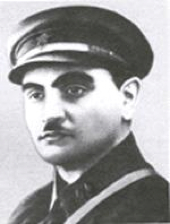 Nakhchivanski Jamshid Jafargulu oglu (10.8.1895, Nakhchivan city -26.8.1938) –a prominent army figure, commander of brigade. He graduated from the Yelizavetgrad (Western Ukraine) guards school (1915). He was the commander of the cavalry, organized from the Moslem people in the World War I (1914-18), took part in breaking the “Brusilav front” and was awarded with the fourth class order “Saint George”. Nakhchivanski who was wounded thrice in the Austria-Romania front was awarded with a silver sword 2nd,3rd, 4th classes “Anna”, 2nd class “Stansilav” orders. After destroy of the South-West front Nakhchivanski stuff rotmistry returned to Azerbaijan together with the regiment he headed and on September 15,1918 cleaned Baki from the dashnaks, eser-menshevics and the “Dictator of Centercaspy” who relied on the English with the help of the Detached Corps of Azerbaijan and Turkish troops. Nakhchivanski also fought resolutely for the independence of Azerbaijan. In March 1920 his regiment situated in Garabagh (Shusha) took a very active part in the operations against the dashnaks and home enemies. After the April occupation (1920) his cavalry kept the side of the bolshevics. That time Nariman Narimanov sent a telegram to Jamshid Nakhchivanski who was in Shusha, urgently to return to Baki and organize the national army forces. Jamshid Nakhchivanski took part in the anti-soviet strikes that happened in Azerbaijan. He was appointed the chief of the Azerbaijan Joint Commander School. In December 1921 he was appointed the commander of the first national infantry division of Azerbaijan and played a great role in the military cadre preparation.
Nakhchivanski studied short-term courses of the Supreme Army Academy in Moscow in 1923 and 1928 years and when returned to Azerbaijan again he was the commander of division. He was one of the editor’s-in-chief of the journal “Military knowledge” published in Azerbaijani by the initiative of general Alagha Shikhliniski in 1922-29 years. Nakhchivanski was sent to the Supreme Military–Political Academy in Moscow named after M.V.Frunze to study in 1931. After graduating from the Academy with honours diploma (1933) he was offered to be a teacher there and headed the chair of the general tactics for 3 years and became a course chief of the key faculty of the academy. Nakhchivanski was appointed the brigade commander military position in 1935.
Nakhchivanski Jamshid Jafargulu oglu (10.8.1895, Nakhchivan city -26.8.1938) –a prominent army figure, commander of brigade. He graduated from the Yelizavetgrad (Western Ukraine) guards school (1915). He was the commander of the cavalry, organized from the Moslem people in the World War I (1914-18), took part in breaking the “Brusilav front” and was awarded with the fourth class order “Saint George”. Nakhchivanski who was wounded thrice in the Austria-Romania front was awarded with a silver sword 2nd,3rd, 4th classes “Anna”, 2nd class “Stansilav” orders. After destroy of the South-West front Nakhchivanski stuff rotmistry returned to Azerbaijan together with the regiment he headed and on September 15,1918 cleaned Baki from the dashnaks, eser-menshevics and the “Dictator of Centercaspy” who relied on the English with the help of the Detached Corps of Azerbaijan and Turkish troops. Nakhchivanski also fought resolutely for the independence of Azerbaijan. In March 1920 his regiment situated in Garabagh (Shusha) took a very active part in the operations against the dashnaks and home enemies. After the April occupation (1920) his cavalry kept the side of the bolshevics. That time Nariman Narimanov sent a telegram to Jamshid Nakhchivanski who was in Shusha, urgently to return to Baki and organize the national army forces. Jamshid Nakhchivanski took part in the anti-soviet strikes that happened in Azerbaijan. He was appointed the chief of the Azerbaijan Joint Commander School. In December 1921 he was appointed the commander of the first national infantry division of Azerbaijan and played a great role in the military cadre preparation.
Nakhchivanski studied short-term courses of the Supreme Army Academy in Moscow in 1923 and 1928 years and when returned to Azerbaijan again he was the commander of division. He was one of the editor’s-in-chief of the journal “Military knowledge” published in Azerbaijani by the initiative of general Alagha Shikhliniski in 1922-29 years. Nakhchivanski was sent to the Supreme Military–Political Academy in Moscow named after M.V.Frunze to study in 1931. After graduating from the Academy with honours diploma (1933) he was offered to be a teacher there and headed the chair of the general tactics for 3 years and became a course chief of the key faculty of the academy. Nakhchivanski was appointed the brigade commander military position in 1935.
At the end of the 30th years as if Nakhchivanski with his “spy group” made close relation with his brothers Davudkhan and Kalbali khan who were in migration (After establishment of the Soviet power in Azerbaijan they got an official permition to go to Iran and in a short period they were promoted to the highest position in the Shah guards. In order to stop their anti-soviet activity the Soviet power brought pressure against the Iran government, sent notes. As a result Kalbali khan was taken out to serve in the front with Azerbaijan. When known that Jamshid Nakhchivanski was a brigade commander in the Soviet Army and his forefathers fought against the Iran army on the side of the Russia troop shah executed them by shooting) and for this, he was accused and underwent repression.
Nakhchivanski was the member of the Central Executive Committee of the Azerbaijan Soviet Federative Socialist Republic. He was awarded with the “Red Flag”, “Red Labour Flag”, “Red Star” orders. There is a Military Cadet school after his name in Baki and streets in Baki and Nakhchivan. His house museum was established in Nakhchivan. Rudolf Ivanov, the popular Russian writer dedicated his work “in the name of the Soviet Union to Jamshid Nakhchivanski”.
Nakhchivani Hindushah ibn-Sanjar
Nakhchivani Hindushah, ibn Sanjar ibn Abdullah as-Sahibi al-Jirani an-Nakhchivani (1245, Giran – 1328) – a historian, linguist scientist, philosopher, writer, translator, poet, secretary and statesman. He studied at religious school Mustansariyya in Baghdad. In 1275 Nakhchivani was a secretary of his brother, the umpire of Kashan, Saydadovle Amir Mahmud and later became a teacher at religious school Mustensariyya. In 1289 he copied “Jame ad-deqaiq fi kashf al-haqiq” by Najmaddin Katib on logic for that school. At the end of the century he worked in the system of finance, became umpire of several provinces and famous as an outstanding statesman and got “Fakhr ad-dovla” alias. He was close friend of Alaaddin Atamalik Juveyn’s son and as a sing of Nakhchivani’s respect to Juveyni he gave “Sahibi” to Juveyn. Nakhchivani had excellent command of Turkish, Arabian, Farsi and Pahlavi (middle Farsi) languages. He always attracted attention with his deep knowledge, sagacity and literary talent. He was occupied with the sciences of philosophy, astrology, mathematics etc. and made a lot of translations. As his present Sadi Shirazi he created the best examples of pure and nice prose in Farsi language. Nakhchivani’s some works survived till the present time. his anthology “Mavarid al-arab”, written in Arabic, was completed in Tabriz in 1307. His other work “Tacarub as-salaf” (“The Experiences of ancestors”), which is about the lives, times and the duties of Arabian caliphs and the history of Amavis, Abbasis and Saljugs, was completed in 1324 and devoted to Grand Lur king Nusrataddin Ahmed bin Yusif (1295-1330).
“Tajarub as-salaf” is known as a translation of “Al-Fakhri” by Arabian scientists Ibn Tagtagi into Farsi language. But along with the pure translation into Farsi Nakhchivani removed its some parts, made his own additions, improved the work and as a result made the work be 3 times bigger that Arabian version. “Tajarub as-salaf”, which is regarded to be the most perfect work on this subject contains information about not only the generation of the author, himself, Shamsaddin Juveyni and other outstanding figures but also about Nakhchivan. The author mentions that Giran belongs to Nakhchivan and Vanand village to Giran and states that Shamsaddin Juveyni (1225-83) built a cloister for dervishes in Vanand and presented him as a property. Nakhchivani’s longing for Nakhchivan shows one more time that he is from there. He asks power and health from the God and to go back to Neshava (Nakhchivan). Nakhchivani’s “Sihah ul-ajam” is a Farsi-Azerbaijani dictionary. The dictionary consists of 21 parts, 393 chapters and 3 main parts – introduction (Arabic language), dictionary and grammar of Farsi language (Arabic language). With the comparison of this dictionary with other this kind of dictionaries we can say that this book contains most Farsi words and 10000 their equivalents in Azerbaijan language. The work is a very valuable source to the lexica and grammar of Azerbaijan and Farsi languages during XII and XIV centuries.
Nakhchivani Mohammad ibn Hidushah
Nakhchivani Mohammad ibn Hindushah ibn Sanjar ibn Abdullah al-Girani an-Nakhchivani (approximately 1293, Nakhchivan - 1376) – a scientist, statesman, confessor. He belongs to the famous scientists’ generation and continued his father’s way, Hindushah Nakhchivani. He got excellent education, had good command of Arabic, Farsi and Turkish languages and learned the different sciences of that time. During the 20th of the XIV century he came to Tabriz and worked in the financial section of Hulakis palace. He worked as a secretary and art person of Qiyasaddin Mohammad Rashidi, who was the son of F. Rashidadin and the grand vizier afterwards and got the pseudonym “Shamsi munshi an-Nakhchivani” for his abilities. He got acquainted with the ruler of Elkhani, Sultan Abu Said Bahadir khan (1316-1335) with the help of Qiyasaddin Mohammad Rashidi and began to write a special work dedicated to the state ruing and construction system, but he could finish it after many years (1366). The second part of his life coincides with the ruling of Chobanis and Jalaris in Azerbaijan. These years he became famous on religious issues and even for a while as a head confessor of the state during Jalaris dynasty. Nakhchivani’s social-political views are same with those of Nizam al-mulk, Rashidaddin and his son Qiyasaddin, as well as Vessaf, Hamdullah Qazvi and other outstanding thinkers. As his ancestors he supported the monarchy system and centralized strong government in the state system. Two works from his scientific collection survived till the present time. “Sihah al-fors”, completed in 1328, is a dictionary of 2300 words used in Farsi language and the explanation of phrases. The work consists of the author’s introduction, 25 parts and 431 chapters. The author used the experience of his ancestors and a lot of other materials of other languages like Azerbaijan and Turkish languages in the explanation of Farsi words. There are ethnographic materials indicating the living conditions of Azerbaijani people. Here you can see the pieces of poems of a lot of masters, as well as his father Hindushah Nakhchivani. The author also gives an explanation to the lexicology and phonetics of the Farsi language. The following years the dictionary compilers used this work as a source. The copies of 4 his manuscripts are known. A.Taati in Tehran published them in 1962.
His second work dedicated to Sheikh Uveys, the ruler of Jalaris and completed in 1366, is “Dastur al-katib fi tayin al-maratib” (“The Instructions for the secretaries to determine the degrees”), consisting of two parts. Here the examples of official documents are attached. But these were not only as an example, but also reflected a lot of real facts about the socio-economic, political, cultural and religious life of that period. The work covers the information about the forms of land property, the rules of land use, taxes and obligations, military construction, military and religious courts, urban life, mastership and trade, the problems of sedentary and nomad agriculture, the miserable condition of the people and their struggle, the explanation of the all positions of feudal hierarchy and about a lot of scientists, statesmen, masters and so on. In his explanation of the position appointments of the ruling system of those times, he cited the factual documents as an example. Here he mentions the names of real historical figures and places. More than 100 historical terms are indicated and the author gives explanation to some of them. The work is estimated on the same level of Nizam al-mulk’s “Siyasatname”, Rashidadin’s “Jami at-tavarikh” and many other works. The copies of his 6 manuscripts are kept in the world libraries. Their scientific-critical text is prepared by academician A.A.Alizadeh (on the basis of the copies of all manuscripts) and was published in 2 editions in Moscow during 1964-1976.
Nakhchivansky Huseyn khan
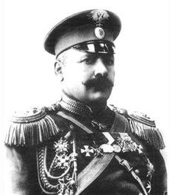 Nakhchivansky Huseyn khan Kalbali khan (28.06.1883, Nakhchivan – 1919, Petrograd) - a military official, General-lieutenant (1915). He Is the son of Kalbali khan Nakhchivansky and the grandson of Ehsan khan Kangarli. When he fifteen years old he was sent to Paj Corpse school in Saint-Petersburg, finished that school with excellent marks in 1881and began to serve in the special cavalry troops of the tsar. Later he did military service in different cities of the Caucasus and Russia and in 1903 he was awarded with the tile of colonel. He commanded to the 2nd Dagestan cavalry regiment gathered from the Caucasians during the Russian-Japan war (1904-1905). In “Diary of Transbaikalie Kazak Officer” by famous Russian journalist A.Kvitka writes about courage of Nakhchivansky’s regiment.
In 1906 he was a commander of lifeguards regiment and was granted with the title of general-major in 1907. In 1921 Nakhchivansky was a commander of the 1st detached cavalry brigade. During the first World War he commanded the 1st and 2nd cavalry division and was distinguished in breaking the german front. A Russian writer, A.Soljenitsin wrote in his “August 14”: “general Huseyn khan Nakhchivansky commanded the guards’ troops that were created from the respectful members of Petersburg nobles”. For his victories and military abilities in the fronts during the First World War Nakhchivansky was awarded with the title of whole cavalry troops general in 1916. Later he was appointed a commander of the Southern Caucasus and left the military profession after the February Revolution (1917). He was awarded with 4 degrees of the Saint George order, the other orders of Saint Vladimir, second degree Saint Alexander, Saint Anna, 2nd and 4th degree Shire-Xurshid of Iran for his Bravery, embroidered with diamond, the Romanian Star for officers, Metal Cross of Austria, the orders of Bulgaria for his Military bravery and 4th degree memorial silver weapon. His grave is in the cemetery of Alexander Nevsky abbey in Saint-Petersburg.
Nakhchivansky Huseyn khan Kalbali khan (28.06.1883, Nakhchivan – 1919, Petrograd) - a military official, General-lieutenant (1915). He Is the son of Kalbali khan Nakhchivansky and the grandson of Ehsan khan Kangarli. When he fifteen years old he was sent to Paj Corpse school in Saint-Petersburg, finished that school with excellent marks in 1881and began to serve in the special cavalry troops of the tsar. Later he did military service in different cities of the Caucasus and Russia and in 1903 he was awarded with the tile of colonel. He commanded to the 2nd Dagestan cavalry regiment gathered from the Caucasians during the Russian-Japan war (1904-1905). In “Diary of Transbaikalie Kazak Officer” by famous Russian journalist A.Kvitka writes about courage of Nakhchivansky’s regiment.
In 1906 he was a commander of lifeguards regiment and was granted with the title of general-major in 1907. In 1921 Nakhchivansky was a commander of the 1st detached cavalry brigade. During the first World War he commanded the 1st and 2nd cavalry division and was distinguished in breaking the german front. A Russian writer, A.Soljenitsin wrote in his “August 14”: “general Huseyn khan Nakhchivansky commanded the guards’ troops that were created from the respectful members of Petersburg nobles”. For his victories and military abilities in the fronts during the First World War Nakhchivansky was awarded with the title of whole cavalry troops general in 1916. Later he was appointed a commander of the Southern Caucasus and left the military profession after the February Revolution (1917). He was awarded with 4 degrees of the Saint George order, the other orders of Saint Vladimir, second degree Saint Alexander, Saint Anna, 2nd and 4th degree Shire-Xurshid of Iran for his Bravery, embroidered with diamond, the Romanian Star for officers, Metal Cross of Austria, the orders of Bulgaria for his Military bravery and 4th degree memorial silver weapon. His grave is in the cemetery of Alexander Nevsky abbey in Saint-Petersburg.
Nakhchivansky İsmail khan
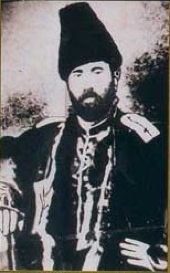 Nakhchivansky İsmail khan Ehsan khan (05.01.1819, Nakhchivan – 1918, Nakhchivan) - a military official, general-lieutenant. He is the son of last khan of Nakhchivan Ehsan khan Kangarli and and the brother of Kalbali khan Nakhchivansky.
He finished Tbilisi Military Gymnasium (1839) and a year later he got first lieutenant title. Many years Nakhchivansky served in the Caucasian Detached Army and he got the titles of staff-captain in 1844 and colonel as a regiment commander in 1860. For his military bravery during the Russian-Turkish war, 1877-1878, he was honored with the title of a cavalry troop general-major. He was released from the army when he possessed the title of general-lieutenant and became occupied with construction work in his motherland, drew water to Nakhchivan, built underground water supplies and a cupola bath house, which is still maintained as a historical monument. He married his son Aman to Khurshud Banu Natavan’s daughter Khanbika and set the relationship with Garabakh khanate. He was awarded with the orders of 1st, 3rd degree “Saint Stanislav”, 3rd and 4th degree “Saint Vladimir” and the 4th degree “Saint George”. Russian writer Valentin Pikul in his “Beyazid” historical novel addressed to Nakhchivansky character and mentioned his bravery and military abilities. Nakhchivansky’s name is also mentioned on the first page of Soviet Military Encyclopedia. It is cited that colonel Nakhchivansky leads to the troops at the difficult battles during the siege of “Beyazid” city by Russians. In some researches Nakhchivansky Ismail khan was confused with his nephew Huseyn khan Nakhchivansky
Nakhchivansky İsmail khan Ehsan khan (05.01.1819, Nakhchivan – 1918, Nakhchivan) - a military official, general-lieutenant. He is the son of last khan of Nakhchivan Ehsan khan Kangarli and and the brother of Kalbali khan Nakhchivansky.
He finished Tbilisi Military Gymnasium (1839) and a year later he got first lieutenant title. Many years Nakhchivansky served in the Caucasian Detached Army and he got the titles of staff-captain in 1844 and colonel as a regiment commander in 1860. For his military bravery during the Russian-Turkish war, 1877-1878, he was honored with the title of a cavalry troop general-major. He was released from the army when he possessed the title of general-lieutenant and became occupied with construction work in his motherland, drew water to Nakhchivan, built underground water supplies and a cupola bath house, which is still maintained as a historical monument. He married his son Aman to Khurshud Banu Natavan’s daughter Khanbika and set the relationship with Garabakh khanate. He was awarded with the orders of 1st, 3rd degree “Saint Stanislav”, 3rd and 4th degree “Saint Vladimir” and the 4th degree “Saint George”. Russian writer Valentin Pikul in his “Beyazid” historical novel addressed to Nakhchivansky character and mentioned his bravery and military abilities. Nakhchivansky’s name is also mentioned on the first page of Soviet Military Encyclopedia. It is cited that colonel Nakhchivansky leads to the troops at the difficult battles during the siege of “Beyazid” city by Russians. In some researches Nakhchivansky Ismail khan was confused with his nephew Huseyn khan Nakhchivansky
Nakhchivanski Kalbali Khan
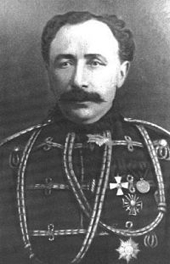 Nakhchivanski Kalbali Khan Ehsan oglu (1824, Nakhchivan -1.5.1883, there) –army figure. Major-general (1874). He is the son of the last Nakhchivan Khan Ehsan Khan Kangarli, brother of Ismayil Khan Nakhchivanski. He was sent to the Paj corps school in his 14 which belonged to the aristocrat children in Petersburg but a sudden disease made him return back to Nakhchivan. After treatment he volunterly took part in the march of Daghistan and for his braveness he was promoted to the rank of officer. In the Crimea war (1853-56) he fought bravely and he was appointed a commander to the Gusar leyb-guard regiment in 1855. Nakhchivanski demonstrated great braveness after being appointed a commander of the Iravan cavalry brigade of Azerbaijanis in the Russian–Turkish war in 1877-78. Nakhchivanski who had a very high prestige among people played an important role in the public–political and cultural life of Nakhchivan. He was awarded with the third-class “Saint Stanislav” order and two “Saint George” orders and also with the sword decorated with diamond.
Nakhchivanski Kalbali Khan Ehsan oglu (1824, Nakhchivan -1.5.1883, there) –army figure. Major-general (1874). He is the son of the last Nakhchivan Khan Ehsan Khan Kangarli, brother of Ismayil Khan Nakhchivanski. He was sent to the Paj corps school in his 14 which belonged to the aristocrat children in Petersburg but a sudden disease made him return back to Nakhchivan. After treatment he volunterly took part in the march of Daghistan and for his braveness he was promoted to the rank of officer. In the Crimea war (1853-56) he fought bravely and he was appointed a commander to the Gusar leyb-guard regiment in 1855. Nakhchivanski demonstrated great braveness after being appointed a commander of the Iravan cavalry brigade of Azerbaijanis in the Russian–Turkish war in 1877-78. Nakhchivanski who had a very high prestige among people played an important role in the public–political and cultural life of Nakhchivan. He was awarded with the third-class “Saint Stanislav” order and two “Saint George” orders and also with the sword decorated with diamond.
Ordubadi Hatembey
Hatembey Malik ogly Ordubadi (?, city of Ordubad – 25.05.1610, Meshed) – is a statesman, figure of culture. He was descendant of Nasreddin Tusi. As his father died he replaced him in the position of kalantar of Ordubad, later served as assistant to judges in Khoy, Yazd and Shiraz. In the first years of the reign of Shah Abbas I [1587-1629] he oversaw the financial affairs of the Sefevi palace, in 1592 was appointed as a vizier (etimadud-dovla) and played significant role in political and economic life of the Sefevi state. After his visit to Ordubad Shah Abbas I gifted this city to Hatembey Ordubadi as remuneration. He carried out extensive renovations in the city and built public buildings. He patronized figures of science and culture. Hatembey Ordubadi was engaged in artistic creation as well, he wrote poems in Turkish (Azerbaijani) and Persian languages under the pseudonym "Safi". Hatembey Ordubadi had died unexpectedly and his body was taken to Tebriz, then to Meshed and buried in the lower part of Imam Rza mausoleum.
Ordubadi Mammad Said
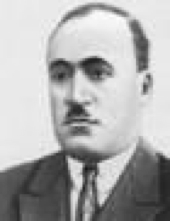 Ordubadi Mammad Said (24.3.1872, Ordubad city – 1.5.1950, Baku, was buried in “Fekhri Khiyaban” (“Honored Avenue”)) – a prose-writer, poet, dramatist, pressman, translator. The Honored Art Worker of Azerbaijani Republic (1938). The poet is Fagir Ordubadi’s son. He got his first education at religious school and later studied at new methodological school “Akhtar” founded by an outstanding enlightener M.T.Sidgi. He lost his father in early ages and therefore had to work as a worker at a silk factory in the city. He began his creative activity at the 90th of the XIX century and wrote the poems criticizing the injustices of that time. his first printed poem “Adabiyyat” (“Literature”), written against intellectual darkness and ignorance was published in the 31th issuance of “The Shargi-Rus” published on the 13th of July in 1903 in Tbilisi. His poem books “Qaflat” (“Ignorance”) was published in1906 and “”Veten ve huriyyet” (“Motherland and freedom”) in 1907 in Tbilisi. “The Molla Nasraddin” magazine that began to be published on April in 1906 affected the future development of the writer. Ordubadi’s topical satire “From the world of politics” was published in the 9th edition of the magazine issued on the 2nd of June in 1906 and he became one of the main associates of the journal he actively took part the newspapers of “The Irshad”, “The Seda”, “The Sedayi-hagg”, “The Tereggi”, “The tazeheyat” and so on and the magazines “The Tuti” and “The Babayi-Amir” published in Baku. In 1907 Ordubadi moved to Julfa and within these years he continued his literary activity and was closely interested in the liberty movement under Sattarkhan’s leadership in the Southern Azerbaijan. Within those years he published his topical satires, poems and articles in “The Molla Nasraddin” magazine and in the newspapers about the life in Iran, published in Baku.
That period the writer published two of his novels “Two kids’ travel to Europe” (1908) and “Unhappy millionaire” (1914). In these works the enlightening ideas are popularized. In 1911 the author described the national massacre tragedy happened with the instigation of the tsar government and the Armenian “Dashnaqsyutun” party during 1905-1906 on the basis of the real facts and documents in his book “Bloody years” published in the “Seda” printing –house of Hashim bey Vezirov with the financial support of millionaire Murtuza Mukhtarov in Baku. In 10th he published his plays “Baghi-shah, or Tehran tragedy” (1910) and “The last days of Andalis or Grenade’s capitulation” (1914). On January in 1915 he was arrested in Julfa and was sent into exile to Tsaritsino (present Volgograd), became close to communists here and a member of the Communist party in 1918. At the beginning of May in 1920 he came to Baku and began to work as a editorial deputy and later an editor of “The Akhbar” newspaper. During 1925=1928 he was an editor of “Yeni Yol” newspaper and a director of “The Molla Nasraddin” magazine after a while. Since 1920 the writer began to work more productively and wrote topical satires and publicity articles, was occupied with the profession of a translator, published poem books, wrote the operas “Koroglu”, “Nargiz” and “Nizami”, the musical comedic librettos “Five mantas bride” and “Heart players” and the play “Misty Tabriz” and printed articles about Nizami, Fuzuli, Vagif, Sanir and others.
His “The literature of Azerbaijan in XII century and its influence to the classic Oriental literature” is a product of very important research. Furthermore, he is known as a founder of the novel genre in the history of Azerbaijani literature. He founded this genre in Azerbaijani literature with his “Misty Tabriz” novel-epopee (1933-1948), which he began to write before the 20th years in 4 editions. In his “Sword and pen” novel (1946-1948), indicating Nizami Ganjavi’s time, he made the character of a genius poet and the socio-political screen of that time. He has historical novels “Fighting city” (1938) and “Secret Baku” (1940). His works were translated to different languages. He was elected a deputy of the Supreme Soviet of Azerbaijan SSR (I-III summon) and was awarded with the orders of Lenin and Honor. Ordubadi’s name has been given to a lot of streets and cultural-educational institutions in the Republic, his memorial houses were created in Ordubad and Baku and his bust was erected in Nakhchivan.
Ordubadi Mammad Said (24.3.1872, Ordubad city – 1.5.1950, Baku, was buried in “Fekhri Khiyaban” (“Honored Avenue”)) – a prose-writer, poet, dramatist, pressman, translator. The Honored Art Worker of Azerbaijani Republic (1938). The poet is Fagir Ordubadi’s son. He got his first education at religious school and later studied at new methodological school “Akhtar” founded by an outstanding enlightener M.T.Sidgi. He lost his father in early ages and therefore had to work as a worker at a silk factory in the city. He began his creative activity at the 90th of the XIX century and wrote the poems criticizing the injustices of that time. his first printed poem “Adabiyyat” (“Literature”), written against intellectual darkness and ignorance was published in the 31th issuance of “The Shargi-Rus” published on the 13th of July in 1903 in Tbilisi. His poem books “Qaflat” (“Ignorance”) was published in1906 and “”Veten ve huriyyet” (“Motherland and freedom”) in 1907 in Tbilisi. “The Molla Nasraddin” magazine that began to be published on April in 1906 affected the future development of the writer. Ordubadi’s topical satire “From the world of politics” was published in the 9th edition of the magazine issued on the 2nd of June in 1906 and he became one of the main associates of the journal he actively took part the newspapers of “The Irshad”, “The Seda”, “The Sedayi-hagg”, “The Tereggi”, “The tazeheyat” and so on and the magazines “The Tuti” and “The Babayi-Amir” published in Baku. In 1907 Ordubadi moved to Julfa and within these years he continued his literary activity and was closely interested in the liberty movement under Sattarkhan’s leadership in the Southern Azerbaijan. Within those years he published his topical satires, poems and articles in “The Molla Nasraddin” magazine and in the newspapers about the life in Iran, published in Baku.
That period the writer published two of his novels “Two kids’ travel to Europe” (1908) and “Unhappy millionaire” (1914). In these works the enlightening ideas are popularized. In 1911 the author described the national massacre tragedy happened with the instigation of the tsar government and the Armenian “Dashnaqsyutun” party during 1905-1906 on the basis of the real facts and documents in his book “Bloody years” published in the “Seda” printing –house of Hashim bey Vezirov with the financial support of millionaire Murtuza Mukhtarov in Baku. In 10th he published his plays “Baghi-shah, or Tehran tragedy” (1910) and “The last days of Andalis or Grenade’s capitulation” (1914). On January in 1915 he was arrested in Julfa and was sent into exile to Tsaritsino (present Volgograd), became close to communists here and a member of the Communist party in 1918. At the beginning of May in 1920 he came to Baku and began to work as a editorial deputy and later an editor of “The Akhbar” newspaper. During 1925=1928 he was an editor of “Yeni Yol” newspaper and a director of “The Molla Nasraddin” magazine after a while. Since 1920 the writer began to work more productively and wrote topical satires and publicity articles, was occupied with the profession of a translator, published poem books, wrote the operas “Koroglu”, “Nargiz” and “Nizami”, the musical comedic librettos “Five mantas bride” and “Heart players” and the play “Misty Tabriz” and printed articles about Nizami, Fuzuli, Vagif, Sanir and others.
His “The literature of Azerbaijan in XII century and its influence to the classic Oriental literature” is a product of very important research. Furthermore, he is known as a founder of the novel genre in the history of Azerbaijani literature. He founded this genre in Azerbaijani literature with his “Misty Tabriz” novel-epopee (1933-1948), which he began to write before the 20th years in 4 editions. In his “Sword and pen” novel (1946-1948), indicating Nizami Ganjavi’s time, he made the character of a genius poet and the socio-political screen of that time. He has historical novels “Fighting city” (1938) and “Secret Baku” (1940). His works were translated to different languages. He was elected a deputy of the Supreme Soviet of Azerbaijan SSR (I-III summon) and was awarded with the orders of Lenin and Honor. Ordubadi’s name has been given to a lot of streets and cultural-educational institutions in the Republic, his memorial houses were created in Ordubad and Baku and his bust was erected in Nakhchivan.
Salayev Eldar
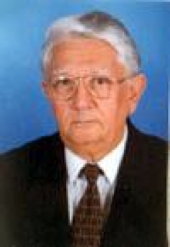 Eldar Yunus oglu Salayev was born in Nakhchivan in 1933. He was a prominent scientist, Doctor of Physical and Mathematical Sciences, professor, and academician of the Azerbaijan National Academy of Sciences. He was also a laureate of the State Prize of Azerbaijan. Salayev headed the Institute of Physics and Photoelectronics for many years. From 1983 to 1997, he served as the President of the Azerbaijan National Academy of Sciences. He is the author of numerous scientific works and monographs on the physics of semiconductors. Under his guidance and based on the results of his studies many devices such as deflectors, decoders, photo receivers, electronic micro-refrigerators, and devices for meteorological research have been created. Eldar Salayev was an outstanding scientist in the field of solid-state physics, quantum electronics and photo electronics. His main research has been dedicated to the studies of semiconductors and the energy spectrum of various solid states. He has discovered for the first time an inductive irradiation in multi-layer crystals with the aid of accelerated cathode beams. This research has facilitated the creation of transformers of laser beams. He is the author of many scientific publications and monographs printed both in Azerbaijan and abroad. Eldar Salayev died on June 20, 2022.
Eldar Yunus oglu Salayev was born in Nakhchivan in 1933. He was a prominent scientist, Doctor of Physical and Mathematical Sciences, professor, and academician of the Azerbaijan National Academy of Sciences. He was also a laureate of the State Prize of Azerbaijan. Salayev headed the Institute of Physics and Photoelectronics for many years. From 1983 to 1997, he served as the President of the Azerbaijan National Academy of Sciences. He is the author of numerous scientific works and monographs on the physics of semiconductors. Under his guidance and based on the results of his studies many devices such as deflectors, decoders, photo receivers, electronic micro-refrigerators, and devices for meteorological research have been created. Eldar Salayev was an outstanding scientist in the field of solid-state physics, quantum electronics and photo electronics. His main research has been dedicated to the studies of semiconductors and the energy spectrum of various solid states. He has discovered for the first time an inductive irradiation in multi-layer crystals with the aid of accelerated cathode beams. This research has facilitated the creation of transformers of laser beams. He is the author of many scientific publications and monographs printed both in Azerbaijan and abroad. Eldar Salayev died on June 20, 2022.
Sidgi Mohammad Taghi
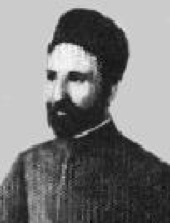 Sidgi (Mohammad Taghi Kerbalayi Safar, Safarov’s pseudonym; 22.3.1854, Ordubad – 09.12.1903, Garabaghlar village of Sharur region)) – an enlightener, pedagogist, poet and publicist. He got religious education and excellently learned classic oriental poetry and philosophy. When he was young he was occupied with trading and opened a café to support his family; this café was a like of cultural centre where gathered educated people and literature amateurs and operated as a library. Sidgi established “Akhtar” school (1892, together with enlightener educated Huseyn Sultan Kangarli) in Ordubad and “Terbiye” (“Mekebi-terbiye”, 1894) in Nakhchivan, became popular as a people teacher and was one of the main organizers of literary-cultural events and theatres. He is the author of 7 scientific-pedagogical manuals (“Numuneyi-ekhlag”, Tehfeyi-benat, or present for Girls”, “Brief geographic booklet” etc.). The manuscript of these works is kept at the Manuscript Institute of the National Scientific Academy of Azerbaijan named after Fizuli. Sidgi was also regularly occupied with literary creative activity. He was one of the active members of “Anjumani-shuara” in Ordubad. His literary heritage related to his pedagogical activity consists of ghazals (more than 300), the voluminous “Mesneviyyati-meneviyye” in verse, the story “Kabb Nasir” in verse, the literary-philosophical treaties “Heykali-insana bir nezer” (in 1912 this work was published as a book) ad more than 20 stories. Sidgi made the first ripe examples of the child prose in Azerbaijan literature. In his works known as ”School stories” (“Go on to school”, “The story of a satisfied child”, “Liar child”, ”Generous child” etc.) he indicated his enlightening ideas, pedagogical views and high spiritual – moral qualities in a literary manner. With his initiative A.S.Pushkin’s 100 years anniversary was celebrated at “Tarbiya” school (1899) and Sidgi made speech on this occasion (his speech was published as a book in 1914). Sidgi was also occupied with publicistic activity, and cooperated with the newspapers “The Tarjuman” (Bagchasaray), “The Akhtar” (Istanbul), “The Hablulmatin” (Kalkut), “The Kaspi” (Baku) and “The Nasiri” (Tabriz) etc. and published his articles. He initiated to issue “The Chirag” newspaper in native language.
Mohammad Taghi Sidgi’s name was given to Nakhchivan State Puppet-show Theatre with the decree of the Supreme Assembly Chief of Nakhchivan Autonomous Republic on “The celebration and memorization of 150 years anniversary of outstanding pedagogist, enlightener and poet Mohammad Taghi Sidgi” dated on March 11, 2004. With this decree it is planed that his memorial boards will be created at schools named after him number 4 in Nakhchivan and number 1 in Ordubad, his selected works will be published and other events will be organized.
His grave is in Nakhchivan.
Sidgi (Mohammad Taghi Kerbalayi Safar, Safarov’s pseudonym; 22.3.1854, Ordubad – 09.12.1903, Garabaghlar village of Sharur region)) – an enlightener, pedagogist, poet and publicist. He got religious education and excellently learned classic oriental poetry and philosophy. When he was young he was occupied with trading and opened a café to support his family; this café was a like of cultural centre where gathered educated people and literature amateurs and operated as a library. Sidgi established “Akhtar” school (1892, together with enlightener educated Huseyn Sultan Kangarli) in Ordubad and “Terbiye” (“Mekebi-terbiye”, 1894) in Nakhchivan, became popular as a people teacher and was one of the main organizers of literary-cultural events and theatres. He is the author of 7 scientific-pedagogical manuals (“Numuneyi-ekhlag”, Tehfeyi-benat, or present for Girls”, “Brief geographic booklet” etc.). The manuscript of these works is kept at the Manuscript Institute of the National Scientific Academy of Azerbaijan named after Fizuli. Sidgi was also regularly occupied with literary creative activity. He was one of the active members of “Anjumani-shuara” in Ordubad. His literary heritage related to his pedagogical activity consists of ghazals (more than 300), the voluminous “Mesneviyyati-meneviyye” in verse, the story “Kabb Nasir” in verse, the literary-philosophical treaties “Heykali-insana bir nezer” (in 1912 this work was published as a book) ad more than 20 stories. Sidgi made the first ripe examples of the child prose in Azerbaijan literature. In his works known as ”School stories” (“Go on to school”, “The story of a satisfied child”, “Liar child”, ”Generous child” etc.) he indicated his enlightening ideas, pedagogical views and high spiritual – moral qualities in a literary manner. With his initiative A.S.Pushkin’s 100 years anniversary was celebrated at “Tarbiya” school (1899) and Sidgi made speech on this occasion (his speech was published as a book in 1914). Sidgi was also occupied with publicistic activity, and cooperated with the newspapers “The Tarjuman” (Bagchasaray), “The Akhtar” (Istanbul), “The Hablulmatin” (Kalkut), “The Kaspi” (Baku) and “The Nasiri” (Tabriz) etc. and published his articles. He initiated to issue “The Chirag” newspaper in native language.
Mohammad Taghi Sidgi’s name was given to Nakhchivan State Puppet-show Theatre with the decree of the Supreme Assembly Chief of Nakhchivan Autonomous Republic on “The celebration and memorization of 150 years anniversary of outstanding pedagogist, enlightener and poet Mohammad Taghi Sidgi” dated on March 11, 2004. With this decree it is planed that his memorial boards will be created at schools named after him number 4 in Nakhchivan and number 1 in Ordubad, his selected works will be published and other events will be organized.
His grave is in Nakhchivan.
Shahtakhtinsky Behdud agha
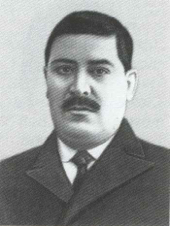 Shahtakhtinsky Behdud agha (1881, Shahtakhti village of Sharur region – 30.5.1924, Tbilisi) – a diplomat.
During 1905-1907 he actively took part in the foundation and activity of the union of the bureau workers in Baku. During 1917-1918 he was a member of Baku Soviet Executive Committee, the extraordinary commission of Baku National Commissars Soviet and chief of the Central Committee of “Hummat” Organization. In 1920 after the foundation of the Soviet Union in Azerbaijan (1920) he was a national justice commissar and at the same time, an extraordinary representative of Azerbaijan SSR in RSFSR. On July-September in 1920 he made comprehensive presentation to V.I.Lenin on Azerbaijan and the situation in the Caucasus, Turkey and Iran. The agreement on a military-economic union between Azerbaijan SSR and RSFSR was signed by V.I.Lenin and B.Shahtahtinsky (September 30, 1920). He was elected a representative of the 2nd congress of the Comintern. During 1921-1924 he worked as chief of the Revolutionary Committee of Nakhchivan, chief of the National Commissars Soviet Nakhchivan Autonomous SSR, National FKM Commissar of Azerbaijan SSR., a chief deputy of the National Commissars Soviet etc. He played important role in the Moscow and Gars agreements which were the essential stage of the acquisition of the status of autonomy of Nakhchivan in the territory of Azerbaijan. His steps in Nakhchivan issues made on the name of Nariman Narimanov in Moscow and his manner in Russian-Turkish negotiations positively affected in the grant of the autonomous status to Nakhchivan as an undivided part of Azerbaijan.
Shahtakhtinsky Behdud agha (1881, Shahtakhti village of Sharur region – 30.5.1924, Tbilisi) – a diplomat.
During 1905-1907 he actively took part in the foundation and activity of the union of the bureau workers in Baku. During 1917-1918 he was a member of Baku Soviet Executive Committee, the extraordinary commission of Baku National Commissars Soviet and chief of the Central Committee of “Hummat” Organization. In 1920 after the foundation of the Soviet Union in Azerbaijan (1920) he was a national justice commissar and at the same time, an extraordinary representative of Azerbaijan SSR in RSFSR. On July-September in 1920 he made comprehensive presentation to V.I.Lenin on Azerbaijan and the situation in the Caucasus, Turkey and Iran. The agreement on a military-economic union between Azerbaijan SSR and RSFSR was signed by V.I.Lenin and B.Shahtahtinsky (September 30, 1920). He was elected a representative of the 2nd congress of the Comintern. During 1921-1924 he worked as chief of the Revolutionary Committee of Nakhchivan, chief of the National Commissars Soviet Nakhchivan Autonomous SSR, National FKM Commissar of Azerbaijan SSR., a chief deputy of the National Commissars Soviet etc. He played important role in the Moscow and Gars agreements which were the essential stage of the acquisition of the status of autonomy of Nakhchivan in the territory of Azerbaijan. His steps in Nakhchivan issues made on the name of Nariman Narimanov in Moscow and his manner in Russian-Turkish negotiations positively affected in the grant of the autonomous status to Nakhchivan as an undivided part of Azerbaijan.
Shahtakhtlinsky Mohammad agha
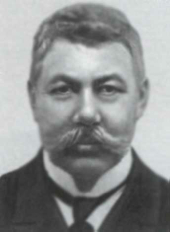 Shahtakhtli, Shahtakhtlinsky Mohammad agha Mohammadtaghi Sultan (1846, Shahtakhti village of Sharur region, - 12.12.1931, Baku) – a publicist, orientalist, linguist, pedagogist and social worker. He was an active member of International Phonetics Society (1899), International “Asian Society” (1900) and the Caucasian Branch of the Russian Emperor Geographic Society (1903). The professor of Baku University (1920). After the graduation from a school in Nakhchivan city and Tbilisi classic men gymnasium (1863) he independently began to learn German language in Petersburg. He graduated from the faculty of Philosophy, History and Law of Leipzig University (1869). During 1873-1875 he listened to the lectures at Eastern Languages School in Paris and learnt French language. He wrote literary and scientific works in Russian, German, French, English, Arabian, Turkish and Farsi languages.
He began his scientific activity with the researches on the history of East in Germany.
The influence of liberal nationalism is seen in his first articles published in 70th years. Shahtakhtinsky is one of the followers of Mirza Fatali Akhundov in alphabetic reforms. In 1879 he published his book “Improved muslim alphabet” in Tbilisi, which was the first published book in the history of the alphabetic reforms of the East. For a while he worked as an associate of “The Moskovkiye Vedomosti” newspaper and a special correspondent in Istanbul. During 1891-1893 Shahtakhtinski was a temporary editor of “The Kaspi” newspaper. In 1898 he tried to publish “The Tbilisi” newspaper in Azerbaijani language but as the tsar censorship did not allow him to publish Shahtakhtinsky went to Europe again, lived in Paris till 1902 and taught oriental languages in French College and High Practical Education School. His works, published in French language these years, caused discussions and debates in the Western European and American literature. Shahtakhtinsky made research on phonetics in Sorbonne University under professor P.Passin’s training and was awarded with the honorary diploma of the Ministry of Enlightening of France.
In 1902 Shahtakhtinsky opened a special printing-house in Tbilisi (later it was called “Qeyret”) and began to print the socio-political, economic, scientific and literary newspaper “The Shargi-Rus”. The newspaper did many things in the development in the history of the public opinion in Azerbaijan. The progressive views related to the issues like secular sciences, mother language and women freedom were indicated on the pages of the newspaper. “The Shargi-Rus” newspaper gathered around itself open-minded writes and press-men, such as Jalil Mammedguluzadeh, Mirza Alakber Sabir, Abbas Sahhat, Omar Faig Nemanzadeh, Huseyn Javid, Mammed Said Ordubadi, Aligulu Qamkuzar and A.Nazmi. This creative staff facilitated to the beginning of the development of a new stage (“The Molla Nasreddin”) in Azerbaijani press. In 1907 Shahtakhtinsky was elected a deputy of the II State Duma in Iravan province and after the closure of the Duma he worked at the editorial office of “The Russia” newspaper (Petersburg) and lived abroad (especially Turkey, Iran and Iraq) during 1908-1918 and returned to his motherland in 1919. He actively took part in the establishment of Baku University and gave lectures on the Oriental languages and literature here. In 1920 he published his articles in the newspapers “Communist”, “Bakinsky rabochiy” and “Gizil Sharg” and was an active member of the All-Union New Turkish Alphabet Committee. In 1922 Shahtakhtinsky was granted with the merit pension.
In his scientific, critical and publicist works Shahtakhtinsky indicated the advanced ideas about colonization, racism, women servitude, state system, democracy, national power, religion, shariat problems and other issues. His present advanced personalities very highly evaluated Shahtakhtinsky’s literary, scientific and press activity.
Shahtakhtli, Shahtakhtlinsky Mohammad agha Mohammadtaghi Sultan (1846, Shahtakhti village of Sharur region, - 12.12.1931, Baku) – a publicist, orientalist, linguist, pedagogist and social worker. He was an active member of International Phonetics Society (1899), International “Asian Society” (1900) and the Caucasian Branch of the Russian Emperor Geographic Society (1903). The professor of Baku University (1920). After the graduation from a school in Nakhchivan city and Tbilisi classic men gymnasium (1863) he independently began to learn German language in Petersburg. He graduated from the faculty of Philosophy, History and Law of Leipzig University (1869). During 1873-1875 he listened to the lectures at Eastern Languages School in Paris and learnt French language. He wrote literary and scientific works in Russian, German, French, English, Arabian, Turkish and Farsi languages.
He began his scientific activity with the researches on the history of East in Germany.
The influence of liberal nationalism is seen in his first articles published in 70th years. Shahtakhtinsky is one of the followers of Mirza Fatali Akhundov in alphabetic reforms. In 1879 he published his book “Improved muslim alphabet” in Tbilisi, which was the first published book in the history of the alphabetic reforms of the East. For a while he worked as an associate of “The Moskovkiye Vedomosti” newspaper and a special correspondent in Istanbul. During 1891-1893 Shahtakhtinski was a temporary editor of “The Kaspi” newspaper. In 1898 he tried to publish “The Tbilisi” newspaper in Azerbaijani language but as the tsar censorship did not allow him to publish Shahtakhtinsky went to Europe again, lived in Paris till 1902 and taught oriental languages in French College and High Practical Education School. His works, published in French language these years, caused discussions and debates in the Western European and American literature. Shahtakhtinsky made research on phonetics in Sorbonne University under professor P.Passin’s training and was awarded with the honorary diploma of the Ministry of Enlightening of France.
In 1902 Shahtakhtinsky opened a special printing-house in Tbilisi (later it was called “Qeyret”) and began to print the socio-political, economic, scientific and literary newspaper “The Shargi-Rus”. The newspaper did many things in the development in the history of the public opinion in Azerbaijan. The progressive views related to the issues like secular sciences, mother language and women freedom were indicated on the pages of the newspaper. “The Shargi-Rus” newspaper gathered around itself open-minded writes and press-men, such as Jalil Mammedguluzadeh, Mirza Alakber Sabir, Abbas Sahhat, Omar Faig Nemanzadeh, Huseyn Javid, Mammed Said Ordubadi, Aligulu Qamkuzar and A.Nazmi. This creative staff facilitated to the beginning of the development of a new stage (“The Molla Nasreddin”) in Azerbaijani press. In 1907 Shahtakhtinsky was elected a deputy of the II State Duma in Iravan province and after the closure of the Duma he worked at the editorial office of “The Russia” newspaper (Petersburg) and lived abroad (especially Turkey, Iran and Iraq) during 1908-1918 and returned to his motherland in 1919. He actively took part in the establishment of Baku University and gave lectures on the Oriental languages and literature here. In 1920 he published his articles in the newspapers “Communist”, “Bakinsky rabochiy” and “Gizil Sharg” and was an active member of the All-Union New Turkish Alphabet Committee. In 1922 Shahtakhtinsky was granted with the merit pension.
In his scientific, critical and publicist works Shahtakhtinsky indicated the advanced ideas about colonization, racism, women servitude, state system, democracy, national power, religion, shariat problems and other issues. His present advanced personalities very highly evaluated Shahtakhtinsky’s literary, scientific and press activity.
Tusi Nasreddin
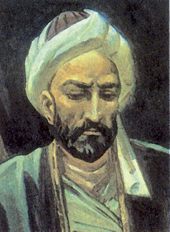 Nasreddin Tusi Mahammad ibn Mahammad ibn Hasan. (17.2.1201, Tus – 25.6.1274, Baghdad) – an encyclopedic scientist, philosopher, socio-political figure. Tusi is his pen name and Nasreddin (defender of religion) is his alias. Abu Abdulla or Abu Jafar was also known instead of the world Mahammad. He was called Khaja (Mister) and also Movla at the same meaning. He got his first education from his father and uncle and later learned the different fields of the humanities and exact sciences in Khorasan. Muinaddin Salim Misri gave Nasreddin Tusi permission to recite had its on the 30th of June in 1222.
Nasreddin Tusi went to Isfahan with the invitation of Nasiraddin Mohtasham, Kuhistan ruler from Ismailis leaders and was welcomed there with respect. But because of a disagreement Nasreddin Tsui began to lose the trust toward him and he was even imprisoned for a while in Alamut castle. Hulaki king released Nasreddin Tusi in 1256 when he put an end to Ismailis dominion and hired Nasreddin an advisor for himself. During the conquest of Baghdad the scientist was famous with his ideas and took care of people, especially the intellectuals and could save them.
About 500 families that left Maragha and Tabriz could return to their motherlands with his help.
One of his main duties is to create Maragha Observatory in the history of science and art of the world in 1259. He assembled more than 100 representatives of different nations here and created good condition for them to work. At religious school attached to the observatory all the fields of science, religion, philosophy and social-political sciences were taught. The school had a library with more than 400 thousand editions. During his visit to Baghdad Nasraddin Tusi died and he was buried in Kazimeyn city, near Baghdad according to his will. The interesting thing is that the tomb that he was buried was built for caliph Nasir-li-Dinillah 75 years, 7 months and 7 days ago but because of some reasons the place was kept empty.
Nasraddin Tusi’s three sons – Sadraddin Ali, Asiladadin Hasan and Fakhraddin Ahmad chose the way of science and at the same time worked in the official bodies. Avhadi Maraghayi (1274-1338) devoted his “Dehname” distich (1306) to Nasraddin Tusi’s grandchild Khaja Ziyaaddin Yusif ibn Asiladdin Hasan. Nasraddin Tusi’s descendants later lived in Nakhchivan and became famous in the spheres of science, literature and art. The decree of the I Shah Abbas (1587-1629) is scraped in the inscription on the gates of big Jume mosque in Ordubad in XVII century that Nasraddin Tusi’s generation lived in Ordubad and therefore the I Shah Abbas released the region from all taxes.
Nasraddin Tusi’s outlook is largely described in his treaties on theology, philosophy, politics and ethics. In thinker’s “Treaties about imamism (religious title)” (“Risab fi-l-imama”) belonging to the Shiite trend, and other works he emphasized not only twelve imams but generally the characteristic qualities of an imam (leader). In his “Jabr ve qadr” (“Algebra and value”) treaties accepts willing freedom. Shiites as well as Sunnis used the thinker’s works, which were far from sect fanaticism.
Nasreddin Tusi Mahammad ibn Mahammad ibn Hasan. (17.2.1201, Tus – 25.6.1274, Baghdad) – an encyclopedic scientist, philosopher, socio-political figure. Tusi is his pen name and Nasreddin (defender of religion) is his alias. Abu Abdulla or Abu Jafar was also known instead of the world Mahammad. He was called Khaja (Mister) and also Movla at the same meaning. He got his first education from his father and uncle and later learned the different fields of the humanities and exact sciences in Khorasan. Muinaddin Salim Misri gave Nasreddin Tusi permission to recite had its on the 30th of June in 1222.
Nasreddin Tusi went to Isfahan with the invitation of Nasiraddin Mohtasham, Kuhistan ruler from Ismailis leaders and was welcomed there with respect. But because of a disagreement Nasreddin Tsui began to lose the trust toward him and he was even imprisoned for a while in Alamut castle. Hulaki king released Nasreddin Tusi in 1256 when he put an end to Ismailis dominion and hired Nasreddin an advisor for himself. During the conquest of Baghdad the scientist was famous with his ideas and took care of people, especially the intellectuals and could save them.
About 500 families that left Maragha and Tabriz could return to their motherlands with his help.
One of his main duties is to create Maragha Observatory in the history of science and art of the world in 1259. He assembled more than 100 representatives of different nations here and created good condition for them to work. At religious school attached to the observatory all the fields of science, religion, philosophy and social-political sciences were taught. The school had a library with more than 400 thousand editions. During his visit to Baghdad Nasraddin Tusi died and he was buried in Kazimeyn city, near Baghdad according to his will. The interesting thing is that the tomb that he was buried was built for caliph Nasir-li-Dinillah 75 years, 7 months and 7 days ago but because of some reasons the place was kept empty.
Nasraddin Tusi’s three sons – Sadraddin Ali, Asiladadin Hasan and Fakhraddin Ahmad chose the way of science and at the same time worked in the official bodies. Avhadi Maraghayi (1274-1338) devoted his “Dehname” distich (1306) to Nasraddin Tusi’s grandchild Khaja Ziyaaddin Yusif ibn Asiladdin Hasan. Nasraddin Tusi’s descendants later lived in Nakhchivan and became famous in the spheres of science, literature and art. The decree of the I Shah Abbas (1587-1629) is scraped in the inscription on the gates of big Jume mosque in Ordubad in XVII century that Nasraddin Tusi’s generation lived in Ordubad and therefore the I Shah Abbas released the region from all taxes.
Nasraddin Tusi’s outlook is largely described in his treaties on theology, philosophy, politics and ethics. In thinker’s “Treaties about imamism (religious title)” (“Risab fi-l-imama”) belonging to the Shiite trend, and other works he emphasized not only twelve imams but generally the characteristic qualities of an imam (leader). In his “Jabr ve qadr” (“Algebra and value”) treaties accepts willing freedom. Shiites as well as Sunnis used the thinker’s works, which were far from sect fanaticism.
